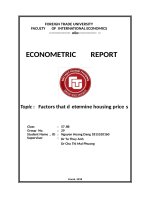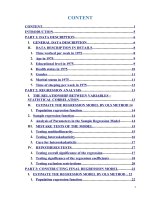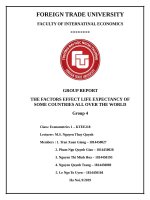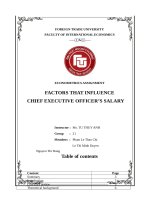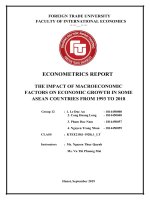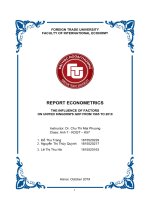tiểu luận kinh tế lượng SOME FACTORS AFFECTING GDP VIETNAM DURING 1995 2011
Bạn đang xem bản rút gọn của tài liệu. Xem và tải ngay bản đầy đủ của tài liệu tại đây (611.95 KB, 30 trang )
FOREIGN TRADE UNIVERSITY
FACULTY OF INTERNATIONAL ECONOMICS
----****----
ECONOMETRICSICSRREPORTPORT
TOPIC:
SOME FACTORS AFFECTING GDP VIETNAM
DURING 1995-2011
Instructor : Dr. Tu Thuy Anh
Group
: Group 143
Members
: TrTốnầnHoàngThịThuNgọc Long
Nguyễn Văn Mạ
Bùi Thị Hoài Tnhương
Class
TìLiênh
Lê Thị
Lăng BíchịT
:6
i
7 Advanced program in
Japanese style international business
K57- English 6-
HHanoi,noi,DOctoberember2019018
Hanoi, October 2019
1
GROUP 143
Member
Tố g Thị Thu
Trần Hoàng Ngọc Long
Bùi Thị Hoài Thươ g
Nguyễn Văn Mạnh
Lăng T ị Tì h
Lê Thị Bích Liên
ID
71552 064
1815520200
7155 065
1815520202
715
068
1815520185
2
Signature
TABLE OF CONTENTS
INTRODUCTION............................................................................................................. 4
I.The reason for choosing the topic.............................................................................. 4
II.Objectives of the study............................................................................................. 4
III. Scope of the study.................................................................................................. 4
IV. Structure of the study............................................................................................. 4
LITERATURE REVIEW................................................................................................... 6
THEORY BACKGROUND............................................................................................... 8
I.Definition.................................................................................................................. 8
1, Gross domestic product (GDP).......................................................................... 8
2, Export................................................................................................................ 9
3, Import.............................................................................................................. 10
4, Investment....................................................................................................... 11
II.The origin of model from theory............................................................................ 11
III.The theory put variables into model..................................................................... 14
DESCREPTIVE STATISTICS OF DATA........................................................................ 15
I.Statistical Description.............................................................................................. 15
II.Correlation Description.......................................................................................... 16
ECOMETRICS MODEL................................................................................................. 17
I.Buiding multiple regression model.......................................................................... 17
II.Running multiple regression model:...................................................................... 17
III.Regression model analysis.................................................................................... 18
ROBUSTNESS CHECK.................................................................................................. 19
FINDING & DISCUSSION............................................................................................. 27
I.Finding.................................................................................................................... 27
II.Discussion.............................................................................................................. 27
CONCLUSION................................................................................................................ 28
REFERENCE................................................................................................................... 29
APPENDIX...................................................................................................................... 30
3
INTRODUCTION
I.The reason for choosing the topic
Total gross domestic product (GDP) is a basic norm which reflects the economic
growth, economic scale, level of economic development per capita, economic structure
and the transformation of price level of a country. Therefore, GDP is an important tool,
commonly used around the world to examine the development and changes in the
national economy. Accurate perception and rational use of this indicator have important
implications in the survey and evaluation for developmental, sustainable, comprehensive
economy. Any countries would also like to maintain a growing economy along with the
monetary stability and occupations for residents, so GDP is one of the specific signal for
the efforts of the government. Thus the study of the tendency of growth of GDP, some
factors affecting GDP can help government change the policies to achieve these
objectives in order to promote economic growth. This is the macro issues that someone
working in the field of economics are concerned. That's why our group decided to study
the subject: “ Some factors affecting GDP Vietnam during 1995-2011”.
II.Objectives of the study
Investigate the influence of three factors: Investment, Export, Import, on GDP in the
period 1995-2011
III. Scope of the study
Total investment, total export, total import and total GDP of Vietnam from 1995 to
2011.
IV. Structure of the study
1. Literature Review
2. Theory Background
3. Descriptive Statistics of Data
4. Ecometrics Model
4
5. Robustness Check
6. Finding & Discussion
7. Conclusion
5
LITERATURE REVIEW
1. “Factors affecting GDP of Ho Chi Minh City”
The subject was about the impact of some factors on GDP of Ho Chi Minh City. It
includes: human resources, investment, exports, imports. Through the survey results, the
study concluded that only the total investment value had a direct effect on GDP in Ho Chi
Minh City. Human resources, total value of exports, imports did not really affect GDP.
From the verified result demonstrated that the regression model was appropriate for
economic theory, the explanatory variables were 99.52% of the fluctuation to GDP of Ho
Chi Minh City.
2. “ The influence of total value of export and import, population, CPI, inflation rate
on GDP during 1990-2009”
The research gave information about some aspects encompassing export, import,
population, CPI and inflation rate between 1990 and 2009. Export, import and population
had an impact on GDP. Three factors determined 99.8184% of the volatility of GDP.
3. “Analyzing the impact of FDI, export, import, population on GDP”
The regression model in this research has shown the great influence of FDI, export,
import and population on GDP. Especially, population is a huge promotion. However, if
increase GDP based on only population, it will cause bad consequences and have a
negative impact on the long-term orientation. Therefore, the study concluded that do not
focus on population but should focus on export to be sustainable development.
4. “Relationship between Export and GDP”
The research has shown that the impact of light industrial and handicraft exports on
GDP is most obvious. With 95% reliability, other factors remained constant, if exports of
light industry and small scale industry increased by US $1 billion, the average value of
GDP increased from 24,614 to 90,032 hundred billion VND.
6
It is estimated that the change in agricultural and fishery export value does not affect
GDP, so if we keep other factors and increase exports of agricultural or fishery products,
economic growth will not be made.
5. “ Analyzing the influence of FDI on GDP”
Foreign direct investment (FDI) actually affected GDP in the period 1995-2010 with
95% reliability. The study also suggested some recommendations to promote GDP
growth: Expanding the investment market, opening the commodity market; Simple
administrative procedures; Loosen monetary and fiscal policies; Incentives and incentives
for investment in industries with high levels of gray matter; Reasonable allocation of
investment capital by sectors and regions.
However, in the articles which has already studied, there has not been any research on
the problem that our group are doing below.
7
THEORY BACKGROUND
In most countries, regardless of political orientation, each country has its own
strategy for social - economic development. Economic growth and development is the
first target of all countries over the world, a key measure of progress in each period of a
country. Not only a country but also Vietnam always consider economic development as a
vital duty. Economic growth illustrates that the growth rate is higher and more stable in a
long time, the economy will achieve many great achievements. So the more stable income
and life of the people, the more developed the country will be. Therefore, economic
development is considered as an attractive issue in economic research, it is a crucial focus
on the whole economy. In order to assess the economy of a country, economists evaluate
through gross domestic product.
I.Definition
1, Gross domestic product (GDP)
a, What is Gross domestic product - GDP
Gross domestic product (GDP) is the monetary value of all the finished goods and
services produced within a country's borders in a specific time period. Though GDP is
usually calculated on an annual basis, it can be calculated on a quarterly basis as well (in
the United States, for example, the government releases an annualized GDP estimate for
each quarter and also for an entire year).
GDP includes all private and public consumption, government outlays, investments,
private inventories, paid-in construction costs and the foreign balance of trade (exports
are added, imports are subtracted). Put simply, GDP is a broad measurement of a nation’s
overall economic activity. It may be contrasted with gross national product (GNP), which
measures a the overall production of an economy's citizens, including those living abroad,
while domestic production by foreigners is excluded.
8
b, The significance of Gross domestic product
Businesses can also use GDP as a guide to decide how best to expand or contract their
production and other business activities. And investors also watch GDP since it provides a
framework for investment decision-making. The "corporate profits" and "inventory" data
in the GDP report are a great resource for equity investors, as both categories show total
growth during the period; corporate profits data also displays pre-tax profits, operating
cash flows and breakdowns for all major sectors of the economy.
2, Export
a, What is export?
An export is a function of international trade whereby goods produced in one country
are shipped to another country for future sale or trade. The sale of such goods adds to the
producing nation's gross output.
Exports are one of the oldest forms of economic transfer and occur on a large scale
between nations that have fewer restrictions on trade, such as tariffs or subsidies. Most of
the largest companies operating in advanced economies derive a substantial portion of
their annual revenues from exports to other countries. The ability to export goods helps an
economy grow. One of the core functions of diplomacy and foreign policy between
governments is to foster economic trade for the benefit of all trading parties.
Exports are a crucial component of a country’s economy. Exports facilitate
international trade and stimulate domestic economic activity by creating employment,
production and revenues.
b, Advantages of exporting for companies
Companies export products and services for a variety of reasons. Exporting can
increase sales and profits if they reach new markets, and they may even present an
opportunity to capture significant global market share. Companies that export spread
business risk by diversifying into multiple markets. Exporting into foreign markets can
often reduce per-unit costs by expanding operations to meet increased demand. Finally,
9
companies that export into foreign markets gain new knowledge and experience that may
allow the discovery of new technologies, marketing practices and insights into foreign
competitors.
c, Challenges of exporting
Companies that export are presented with a unique set of challenges. Extra costs are
likely to be realized because companies must allocate considerable resources to
researching foreign markets and modifying products to meet local demand and
regulations. Companies that export are typically exposed to a higher degree of financial
risk. Payment collection methods, such as open-account, letter of credit, prepayment and
consignment, are inherently more complex and take longer to process than payments from
domestic customers.
3, Import
a, What is import?
An import is a good or service brought into one country from another. The word
"import" is derived from the word "port" since goods are often shipped via boat to foreign
countries. Along with exports, imports form the backbone of international trade. If the
value of a country's imports exceeds the value of its exports, the country has a negative
balance of trade.
Countries are most likely to import goods that their domestic industries cannot
produce as efficiently or cheaply as the exporting country. Countries may also import raw
materials or commodities that are not available within its borders. For example, many
countries import oil because they cannot produce it domestically or cannot produce
enough to meet demand. Free trade agreements and tariff schedules often dictate which
goods and materials are less expensive to import.
b, What affects import?
The United States' largest trading partners include China, Canada and Mexico. Two of
these countries are involved in the North American Free Trade Agreement that was
implemented in 1994 and, at the time, created one of the largest free-trade zones in the
10
world. With very few exceptions, this allowed the free movement of goods and materials
between the United States, Canada and Mexico.
It is widely believed NAFTA has reduced automotive parts and vehicle manufacturing
in the United States and Canada, with Mexico being the main beneficiary of the
agreement within this sector. The cost of labor in Mexico is much cheaper than in the
United States or Canada, pushing automakers to relocate their factories to Mexico.
4, Investment
An investment is an asset or item acquired with the goal of generating income or
appreciation. In an economic sense, an investment is the purchase of goods that are not
consumed today but are used in the future to create wealth. In finance, an investment is a
monetary asset purchased with the idea that the asset will provide income in the future or
will later be sold at a higher price for a profit.
The term "investment" can refer to any mechanism used for generating future income.
In the financial sense, this includes the purchase of bonds, stocks or real estate property.
Additionally, a constructed building or other facility used to produce goods can be seen as
an investment. The production of goods required to produce other goods may also be seen
as investing.
Taking an action in the hopes of raising future revenue can also be considered an
investment. For example, when choosing to pursue additional education, the goal is often
to increase knowledge and improve skills in the hopes of ultimately producing more
income.
II.The origin of model from theory
1. Calculation method according to expenditure
This method is calculated by adding up the spending:
GDP=Y=C+I+G+NX
Inside:
- Consumer spending (C): Includes all expenditures for products and services
produced and sold by enterprises to households.
11
- Investment expenditure (I): Total investment capital for social development in
the period. Investment capital for social development includes:
• Capital construction investment includes construction capital, capital for
procurement of equipment, other capital construction, livestock for plowing,
breeding ...
• Capital to increase mobile assets in the period such as increasing inventory
between the end of the period and the beginning of the year in terms of raw
materials, materials, finished products and goods in circulation, products
produced in agricultural and non-agricultural households, and warehouses. state
reserve.
- Government spending on products and services (G) includes expenditures by
central and local governments. These are the costs for defense, administrative,
medical, court education, costs to maintain public order, public works, infrastructure
construction ...
- Net export (NX) is the difference between export and import of the economy.
This is a spending reflecting the economic relationship with foreign countries of the
country. GDP calculated by expenditure method is GDP calculated by market price
because the expenditure is paid at market price.
2. Calculation method according to income
Under this method, in a simple economy, GDP is calculated by adding up all the
income that the enterprise sector distributes to households in the form of wages, interest,
rent and profit.
GDP = Y = Salary + interest + rent + profit.
The calculation of GDP by income is also called factor price GDP because these
enterprises pay for the use of resources for production. If the economy does not have a
government, the calculation of GDP at market prices or price factors will give the same
result. But when there is a government, there should be adjustments to GDP based on
income similar to GDP at market prices.
12
The first adjustment is to add indirect tax to income. The government receives
income from indirect taxes, ie taxes levied on services and goods on the market, in which
government subsidies for production are considered to be an indirect tax.
The second adjustment is the addition of depreciation along with earnings. Because,
when calculating GDP at market price, depreciation has been calculated in investment
expenditure, while calculation of GDP by income does not include depreciation.
Therefore, the formula for calculating GDP when there is a government:
GDP = Total income = Salary + Interest + Rent + Profit + indirect tax +
depreciation.
3.Calculation method according to added value
The value-added method is the sum of all the added value of the economy in a period.
Gross domestic product = Added value + import tax
Or GDP = Production value - intermediate cost + import tax
- The added value of the entire economic sector is determined for the whole country
and for each territory and by the total value added of economic sectors and economic
sectors.
- Added value of each economic sector including:
• Producers' incomes such as salaries and wages (including cash or in kind and
paychecks), deductions for social insurance, health insurance, superior union
payments, income other than salary, wages.
• Production taxes include: Goods tax (excluding import taxes) production taxes
and other costs. Production tax does not include direct taxes such as income tax,
corporate income tax ...
• Depreciation of fixed assets.
• Surplus value
• Mixed income
- The added value of an enterprise is the difference between the output value of the
enterprise and the value of the material elements purchased by the enterprise from other
enterprises.
13
III.The theory put variables into model
According to the Dr. Nguyen Van Cong, GDP is the total market value of all final
goods and services produced in a given period. The basic factors affecting the growth of
GDP consists of the following key factors:
First, human resources. Some people view that as the core of economic growth.
People who have health, intellect, qualification, enthusiasm, motivation will be the basic
factor of economic growth.
Second, investment. In order to produce goods, buy machinery and equipment,
expand production scale, improve skills for employees, we need capital investment.
Harod Domar stated the relationship between investment and economic growth with the
ICOR formula, which is the rate of investment increase divided by the rate of GDP
growth.
Third, natural resources. Countries with abundant natural resources will be
advantageous conditions for economic development. Not only can it be exploited and put
into production, but it can also serve export and purchase necessary goods.
Fourth, intellectual technology. Science and technology has always been the magic
key to open the gate to a tremendous economic growth. Science and technology helps
increase productivity and production efficiency, which can cause a sudden increase in
output.
Last but not least, net exports. We live in an open economy, participate in the world
economy and have relations with other countries through trade and finance. We export the
cheapest goods and services manufactured in the country and import other goods that
have cost advantages. The gap between exports and imports is net exports. Net exports
have a direct impact on economic growth, as it is a part of manufactured goods and
services. Increased net exports will boost production of more products.
14
DESCREPTIVE STATISTICS OF DATA
I.Statistical Description
We summarize the data in the following table:
GDP
Mean
853482.8
Maximum
2415204
Minimum
228677
Investment (In)
346008.35
877850
72447
Export (Ex)
32082.5
96905.7
5448.9
Import (Im)
38213.3
106750
8155.4
From the graph, we can see:
+ GDP variable has:
Minimum value is 228677 billion VND.
Maximum value is 2415204 billion VND.
Average value is 853482.8 billion VND/year.
15
+ Investment (In) variable has:
Minimum value is 72447 billion VND.
Maximum value is 877850 billion VND.
Average value is 346008.35 billion VND/year.
+ Export (Ex) variable has:
Minimum value is 5448.9 billion VND.
Maximum value is 96905.7 billion VND.
Average value is 32082.5 billion VND/year.
+ Import (Im) variable has:
Minimum value is 8155.4 billion VND.
Maximum value is 106750 billion VND.
Average value is 38213.3 billion VND/year.
II.Correlation Description
Before going deeper into the econometric model, we’ll have a look at the correlation
between variables.
Correlation coefficients, using the observations 1995 - 2011
5% critical value (two-tailed) = 0.4821 for n = 17
GDP
1.0000
In
0.9870
1.0000
Ex
0.9938
0.9844
1.0000
Im
0.9843
0.9873
0.9948
1.0000
GDP
In
Ex
Im
The result gives us some information:
+ The correlation level between GDP and In is 98.70%
+ The correlation level between GDP and Ex is 99.38%
+ The correlation level between GDP and Im is 98.43%.
16
ECOMETRICS MODEL
I.Buiding multiple regression model
The model consists of 4 variables:
+ Dependent variable: Gross Domestic Product (GDP) (billion VND/year)
+ Independent variables:
Investment: In (billion VND/year)
Export: Ex (billion VND/year)
Import: Im (billion VND/year)
Sample regression model:
GDP = β1 + β2 In + β3 Ex + β4 Im + ui
II.Running multiple regression model:
We run the regression model by Gretl and the table below is the result:
Model 1: OLS, using observations 1995-2011 (T = 17)
Dependent variable: GDP
Coefficient
80485.3
Std. Error
20022.8
t-ratio
4.020
p-value
0.0015
***
In
1.14732
0.284716
4.030
0.0014
***
Ex
31.0314
4.48987
6.911
<0.0001
***
Im
−16.2129
4.25889
−3.807
0.0022
***
const
Mean dependent var
Sum squared resid
853482.8
3.04e+10
S.D. dependent var
S.E. of regression
636263.3
48368.33
R-squared
0.995305
Adjusted R-squared
0.994221
F(3, 13)
918.5575
P-value(F)
2.23e-15
−205.2139
Akaike criterion
418.4278
Schwarz criterion
421.7607
Hannan-Quinn
418.7591
rho
0.575681
Durbin-Watson
0.835498
Log-likelihood
From the above result, we have the regression model as follows:
17
GDP= 80485.3 + 1.14732In + 31.0314Ex -16.2129Im + ui
III.Regression model analysis
+ Number of observations: 17
+ R-squared = 0.995305 => Investment, export, import explain about 99.5305% of
the variation of GDP.
+ Meaning of coefficients:
β1= 80485.3 means: the total value of investment, export and import equal 0
at the same time, the average of GDP is 80485,3 billion VND/year.
β2= 1.14732 means: Export, Import constant, total investment increase
(decrease) 1 billion VND/year, GDP increase (decrease) 1,14732 billion
VND/year.
β3= 31.0314 means: total investment, import constant and if export increase
(decrease) 1 billion vnd/year, GDP increase (decrease) 31,0314 billion
VND/year.
β4 = −16.2129 means: total investment, export constant import increase
(decrease) 1 billion VND/year, GDP decrease (increase) 16,2129 billion
VND/year.
18
ROBUSTNESS CHECK
I.Hypothesis test
1. Testing individual regression coefficient (P-value method)
By P- value method, we can test the influence of each independent variable, which
includes In, Ex, Im on the value of dependent variable GDP.
Two-side testing:
β2
Pair of hypothesis:
H0: β2= 0
H1: β2≠ 0
P-value= 0.0014 < α = 0.05 => reject H0 => β2 influences to Y
β3
Pair of hypothesis:
H0: β3= 0
H1: β3≠ 0
P-value= <0.0001 < α = 0.05 => reject H0 => β3 influences to Y
β4
Pair of hypothesis:
H0: β4= 0
H1: β4≠ 0
P-value= 0.0022 < α = 0.05 => reject H0 => β4 influences to Y
→ Conclusion: the regression coefficients of variables In, Ex, Im are statistically
influenced on GDP.
2. Testing the overall significance
Hypothesis:
H0=β2=β3=β4=0
H1=β2+β3+β4≠0
19
FS= 918.5575 > 3.41 => reject H0
In another way, from OLS table, we also have result:
F(3, 13)
918.5575
P-value(F)
2.23e-15
The P-value for the F-test is 2.23e-15 << α = 0.05. Therefore, we reject H0 and
not reject H1 which means all the slope coefficients of independent variables are not
simultaneously equal to 0. To summarize, our regression model is fit.
II.Checking for multicollinearity, normality and heteroskedasticity
1. Testing for multicollinearity
Multicollinearity (also collinearity) is a phenomenon in which one predictor variable
in our regression model can be linearly predicted from the others with a substantial
degree of accuracy. In this situation the coefficient estimates of the multiple regression
may change erratically in response to small changes in the model or the data.
There are certain reasons why multicollinearity occurs:
It is caused by an inaccurate use of dummy variables.
It is caused by the inclusion of a variable which is computed from other
variables in the data set.
Multicollinearity can also result from the repetition of the same kind of variable.
Generally occurs when the variables are highly correlated to each other.
How to cure :
Collect more data
Use other source of information
Delete one or more variables
Transform the variables: taking log, ratio,…
In Gretl, we can use the correlation matrix to test for multicollinearity. If the value of
corr between 2 variables is greater than 0.8, we can conclude that there is
20
multicollinearity phenomenon in our regression model.
We get the following result:
Correlation coefficients, using the observations 1995 - 2011
5% critical value (two-tailed) = 0.4821 for n = 17
In
1.0000
Ex
0.9844
Im
0.9873
In
1.0000
0.9948
Ex
1.0000
Im
From the above results demonstrates:
The correlation coefficient between In and Ex is 0.9844 > 0.8
The correlation coefficient betweem In and Im is 0.9873 > 0.8
The correlation coefficient between Ex and Im is 0.9948 > 0.8
→ The model occurs multicollinearity phenomenon.
SOLUTION:
a.Remove variable “In”:
Regression model after removing variable “In”:
Model 5: OLS, using observations 1995-2011 (T = 17)
Dependent variable: GDP
Coefficient
105714
Std. Error
27485.0
t-ratio
3.846
p-value
0.0018
***
Ex
33.5316
6.42628
5.218
0.0001
***
Im
−8.58365
5.51314
−1.557
0.1418
const
Mean dependent var
Sum squared resid
853482.8
6.84e+10
S.D. dependent var
S.E. of regression
636263.3
69899.43
R-squared
0.989440
Adjusted R-squared
0.987931
21
F(2, 14)
655.8519
Log-likelihood
−212.1034
P-value(F)
1.46e-14
Akaike criterion
430.2069
Schwarz criterion
432.7065
Hannan-Quinn
430.4554
rho
0.354849
Durbin-Watson
1.286398
2
=> R
reject In
= 0.989440
b.Remove variable “Ex”:
Regression model after removing variable “Ex”:
Model 6: OLS, using observations 1995-2011 (T = 17)
Dependent variable: GDP
Coefficient
Std. Error
t-ratio
p-value
const
58315.0
41176.6
1.416
0.1786
In
1.41924
0.587486
2.416
0.0299
Im
7.95790
5.06379
1.572
0.1384
**
Mean dependent var
853482.8
S.D. dependent var
636263.3
Sum squared resid
1.42e+11
S.E. of regression
100770.6
R-squared
0.978052
Adjusted R-squared
0.974916
F(2, 14)
311.9307
P-value(F)
2.45e-12
−218.3219
Akaike criterion
442.6437
Schwarz criterion
445.1434
Hannan-Quinn
442.8922
rho
0.639165
Durbin-Watson
0.855499
Log-likelihood
2
=> R
reject Ex=
0.978052
22
c.Remove variable “Im”:
Regression model after removing variable “Im”:
Model 7: OLS, using observations 1995-2011 (T = 17)
Dependent variable: GDP
const
Coefficient
77945.0
Std. Error
28042.8
t-ratio
2.779
p-value
0.0148
**
In
0.665489
0.357389
1.862
0.0837
*
Ex
16.9960
3.59071
4.733
0.0003
***
Mean dependent var
Sum squared resid
853482.8
6.43e+10
S.D. dependent var
S.E. of regression
636263.3
67779.82
R-squared
0.990070
Adjusted R-squared
0.988652
F(2, 14)
697.9576
P-value(F)
9.52e-15
−211.5800
Akaike criterion
429.1599
Schwarz criterion
431.6596
Hannan-Quinn
429.4084
rho
0.647029
Durbin-Watson
0.755837
Log-likelihood
2
=> R
reject Im
= 0.990070
Comparing 3 regression models, we can see that
R2reject Ex < R2reject In < R2reject Im .
Therefore, we can remove the variable “Im” out of the model.
2. Testing for Heteroscedasticity
Heteroskedasticity: Recall that OLS makes the assumption that Vj(ε) = σ2 for all j.
That is, the variance of the error term is constant. (Homoskedasticity). If the error
terms do not have constant variance, they are said to be heteroskedastic.
We have the pair of hypothesis as below:
H0: The residuals are homoscedastic
H1: The residuals are heteroscedastic
23
Using White’s test for heteroskedasticty in Gretl, we get the result as below:
White's test for heteroskedasticity
OLS, using observations 1995-2011 (T = 17)
Dependent variable: uhat^2
coefficient
std. error
t-ratio
p-value
---------------------------------------------------------------const
−2.41057e+09
3.45944e+09 −0.6968 0.5084
In
−165361
123981
−1.334
0.2240
Ex
767585
1.45210e+06
0.5286
0.6134
Im
1.16147e+06
872875
1.331
0.2250
sq_In
0.238021
0.556187
0.4280 0.6815
X2_X3
0.427921
16.6303
0.02573 0.9802
X2_X4
−1.95616
18.5019
−0.1057 0.9188
sq_Ex
431.091
368.592
1.170
0.2805
X3_X4
−727.563
717.891
−1.013
0.3446
sq_Im
297.804
358.264
0.8312
0.4333
Unadjusted R-squared = 0.713782
Test statistic: TR^2 = 12.134290,
with p-value = P(Chi-square(9) > 12.134290) = 0.205844
→
The result illustrates that: TR^2 = 12.134290 with p-value= 0.205844 > 0.05 so we
accept the hypothesis H0: The residuals are homoscedastic. It refers to regression model
of GDP according to In, Ex, Im does not occur heteroscedasticity.
3. Testing for normality
According to the Basic assumptions of OLS (Gaus-Makov), we have the 5th
assumption: u ~ N(0,σ2).
Consequence:
+If this assumption does not hold, then estimates are still unbiased, but we will
not be able to assess which parameters are significant
+ The normality of the estimates is not hold
+ The significant tests will not follow the t-student distribution
24
+ The joint significant test will not follow an F
distribution Pair of hypothesis:
H0: u follows normal distribution
H1: u doesn’t follow normal distribution
Using Normality of Residual in Gretl, we get the result:
Frequency distribution for uhat1, obs 1-17
number of bins = 7, mean = 1.64351e-010, sd = 48368.3
interval
midpt
frequency
rel.
< -8.870e+004 -1.014e+005
5.88% **
-8.870e+004 - -6.327e+004 -7.598e+004
**
-6.327e+004 - -3.784e+004 -5.056e+004
**
-3.784e+004 - -1.241e+004 -2.513e+004
****
-1.241e+004 - 1.301e+004 298.6
58.82% **********
1.301e+004 - 3.844e+004 2.573e+004
82.35% ********
>= 3.844e+004 5.115e+004
100.00% ******
1
5.88%
1
5.88%
11.76%
1
5.88%
17.65%
2
11.76%
29.41%
5
29.41%
4
23.53%
Test for null hypothesis of normal distribution:
Chi-square(2) = 4.257 with p-value 0.11902
25
cum.
3
17.65%

